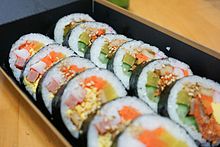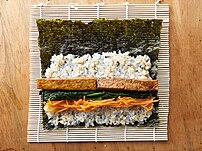김밥
Gimbap 야채김밥 | |
| 원산지 | 코리아 |
|---|---|
| 주성분 | 김, 밥. |
| 변주곡 | 충무김밥 삼각김밥 |
| 한국이름 | |
| 한글 | 김밥 |
|---|---|
| 로마자 표기법 개정 | 김밥 |
| 맥쿤 라이샤워 | 김밥 |
| IPA | [ki(ː)m.bap̚]~[ki(ː)m.p͈ap̚] |
김밥(한국어: 김밥;김밥; IPA:[kim.p ͈ap ̚])는 김밥이라고도 하며, 밥, 야채, 생선, 고기를 김에 말아서 한 입 크기로 제공하는 한국 음식입니다. 김밥의 기원에 대해서는 논쟁이 있습니다. 어떤 자료들은 그것이 일본 식민지 시대에 소개된 일본의 노리마키에서 유래되었다고 주장하는 반면,[2][3][4][5] 다른[who?] 자료들은 그것이 조선 시대의 복쌈의 현대화된 버전이라고 주장합니다.[6] 이 요리는 종종 소풍이나 야외 행사에서 먹을 수 있는 포장된 식사의 일부, 즉 도시락이며, 단무지와 김치와 함께 가벼운 점심 식사로 제공됩니다. 국내와 해외에서[7] 인기 있는 테이크아웃 음식으로 휴대성이 좋아 간편식으로 알려져 있습니다.
어원
김(김)은 포르피라속과 파이로피아속에 속하는 식용 해조류를 말합니다. 밥(밥)은 일반적으로 밥을 짓는 것을 말합니다. 김밥이라는 합성어는 신조어입니다; 그것은 현대 시대까지 한국어의 일부가 아니었습니다.[when?] 김으로 말아서 지은 밥과 비슷한 음식은 조선시대에 복쌈(福; 복쌈-)이라고 불렸습니다.
김밥이라는 용어는 1935년 한국 신문 기사에서[10] 사용되었지만 그 당시에는 노리마키라는 외래어도 사용되었습니다. 비슷한 일본 요리의 이름에서 차용한 노리마키는 일제 강점기 (1910–1945) 동안 한국어에 들어온 일본어 어휘의 일부였습니다. 김밥이 보편적인 용어가 될 때까지 두 단어는 일본 식민주의의 잔재를 청산하고 한국어를 순화하기 위한 노력의 일환으로 혼용되었습니다.[11]
역사
김밥의 기원에 대해서는 논쟁이 있습니다.[12] 일반적으로 받아들여지는 한 이론은 이 요리가 한국의 일본 점령 시기에 일본 초밥 변종 마끼즈시가 한국에 도입된 것에서 유래되었다고 제안합니다. 그 기간 동안 한국 요리는 서양 음식과 음료뿐만 아니라 도시락이나 초밥과 같은 일본 음식을 채택했습니다.[2][13][14][15] 그 이후로 김밥은 쌀 식초 대신 참기름뿐만 아니라 한국 전통 맛을 사용하는 독특한 음식이 되었습니다.[16][17] 김밥이라는 용어가 한국에서 처음 등장한 1935년 신문에서 이 이론을 뒷받침하고 있습니다.[10]
한국학중앙연구원이 발간한 한국문화대백과에 제시된 대안적인 이론은 김에 밥을 말아 먹고 반찬을 하는 오랜 현지 전통에서 발전된 음식이라는 것입니다.[12][18][19] 경상도지리지, 신증동국여지승남 등 15세기 책에 경상도와 전라도의 김(김) 제작이 보고되어 있습니다. 김매선(김매순)이 1819년에 쓴 조선의 책 여량세시기(열양세시기)는 밥을 지어 김을 말아서 만든 것을 복쌈(縛占; 한자 복쌈을 사용하여 옮겨 적은 것, 우리말로 박점으로 발음함)이라고 합니다. 또 다른 이론은 김밥이 백제 시대에 일본에 전래되었고, 그곳에서 마침내 노리마키로 발전했다고 합니다.[22][23]
그럼에도 불구하고, 김밥과 마끼즈시는 이제 일본과 한국에서 구별되는 음식을 말합니다: 전자는 일본어로 기무파푸(キムパプ), 후자는 한국어로 기무밥(김초밥; "김초밥") 또는 노리마키(노리마키). 김밥은 보통 여러 재료를 넣고 말아 참기름으로 간을 하고, 마끼즈시는 보통 한 재료(오이 또는 생참치)를 넣고 말아 밥식초로 간을 합니다.[citation needed]
재료 및 준비물
김밥의 두 가지 기본 구성 요소는 김과 밥입니다. 단립 백미가 가장 일반적으로 사용되지만 단립 현미, 흑미 또는 기타 곡물이 충전재 역할을 할 수도 있습니다.[citation needed]
김밥의 종류에는 치즈, 매운 요리 오징어, 김치, 점심 고기, 돈가스, 후추 또는 매운 참치가 있습니다. 김은 참기름으로 닦거나 참깨를 뿌릴 수 있습니다. 한 가지 변형으로, 얇게 썬 김밥 조각을 계란 코팅으로 살짝 튀길 수 있는데, 이렇게 하면 오래된 김밥을 먹을 수 있습니다.[citation needed]
속은 채식주의자와 채식주의자 옵션에 따라 다양합니다.[24] 인기 있는 재료로는 단무지, 햄, 쇠고기, 모조 게살, 계란지단, 김치, 불고기, 시금치, 당근, 우엉, 오이, 참치 통조림 또는 깐느잎이 있습니다.[25][26]
요리는 김 시트를 약한 불에서 굽고, 밥은 소금과 참기름으로 살짝 간을 하고, 야채와 고기 재료는 양념을 해서 볶거나 팬에 튀깁니다. 구운 김은 얇은 층의 익힌 밥을 위에 고르게 얹은 대나무 김밥 롤러인 짐벌 위에 올려집니다. 다른 재료들은 쌀 위에 올려지고 원통형으로 말려지는데, 보통 지름이 3-4센티미터(1.2-1.6인치)입니다. 그런 다음 말린 김밥을 한입 크기로 자릅니다.[27]
변종

- 충무김밥 - 바닷가 도시 충무(현 통영)에서 유래된 이 음식은 양념되지 않은 표면에 쌀만 넣은 얇은 롤이 특징입니다. 매운 오징거무침과 석박지가 함께 나옵니다.[28]
- 마약김밥 - 서울 광장시장의 명물 마약김밥 Mayak은 중독성 있고 농축된 맛이라고 알려진 것을 지칭하는 "drug"로 번역됩니다. 당근, 시금치, 단무지 등으로 속을 채운 작은 김밥에 간 깨를 뿌리고 간장과 겨자로 만든 페어링 소스에 찍어 먹습니다.
- 삼각김밥(삼각김밥) - 말 그대로 "삼각김밥"입니다. 이 품종은 일본 오니기리와 비슷하여 한국의 편의점에서 판매합니다.[29] 충전물은 매우 다양하며, 유통기한은 하루이며, 일반적으로 600~850킬로줄(140~200kcal)의 음식 에너지를 제공합니다.[citation needed]
- 누드 김밥 - 전통적인 김밥과 달리 누드 김밥의 재료가 김 안에 들어가는 동안 밥이 겉을 감싸며 마치 캘리포니아 롤과 유사합니다. 하지만 캘리포니아 롤과 달리 누드 김밥은 여전히 전통적인 김밥 재료를 사용합니다.
- 육회 김밥 - 육회김밥 - 이 종류는 일본의 생해물 마끼즈시와 비슷하지만 단무지, 깐닙, 파를 곁들인 한국의 생고기 요리인 육회를 사용합니다.
외식프랜차이즈
많은 한국 패스트푸드점 프랜차이즈는 김밥과 국수를 전문으로 합니다. 체인점 중에는 김밥천국(김밥천국), 꼬봉민김바빈(고봉민김밥人), 충무김밥맛죽(충무김밥ᄆᆞᆺ죽), 김선생(바르다김선생), 김밥나라(김밥나라), 김가네(김家네), 고봉김밥(고봉김밥), 종로김밥(종로김밥), 롤링밥, 김밥왕(김밥), 찰스솟불김밥(찰스숯불김밥) 등이 있습니다.
참고 항목
참고문헌
- ^ National Institute of Korean Language (30 July 2014). "주요 한식명(200개) 로마자 표기 및 번역(영, 중, 일) 표준안" (in Korean). Archived (PDF) from the original on 23 January 2019. Retrieved 15 February 2017.
- 주요 한식명 로마자 표기 및 표준 번역 확정안 공지. National Institute of Korean Language (Press release) (in Korean). 2 May 2014.
- ^ a b Levinson, David; Christensen, Karen (2002). Encyclopedia of Modern Asia: China-India relations to Hyogo. Charles Scribner's Sons. ISBN 0-684-80617-7. Archived from the original on 18 September 2023. Retrieved 3 May 2021.
This process was initiated during the Japanese occupation (1910-1945), when Western food and drink, such as bread, confectionery, and beer, became popular in Korean cities, and a Western-style food processing industry in Korea began. Some Japanese food items were also adopted into Korean cuisine at that time, such as tosirak (the assorted lunch box) and sushi rolled in sheets of seaweed, which was popular in Korea under the name of kimbap.
- ^ Brunner, Anne (2011). Algas/ Algae: Sabores Marinos Para Cocinar/ Marine Flavors for Cooking (in Spanish). Editorial HISPANO EUROPEA. ISBN 978-84-255-1977-2. Archived from the original on 18 September 2023. Retrieved 3 May 2021.
En Corea, los gimbaps son derivados de los maki sushis japoneses, pero generalmente estan rellenos de arroz con aceite de sesamo y carne.
[In Korea, gimbaps are derived from the Japanese maki sushi, but they are usually stuffed with rice with sesame oil and meat.] - ^ 김밥 [Gimbap] (in Korean). 한국민족문화대백과[Encyclopedia of Korean National Culture]. Archived from the original on 24 March 2012.
일본음식 김초밥에서 유래된 것으로
[(Gimbap is) derived from Japanese norimaki] - ^ 국립국어연구원 [National Institute of Korean languages] (2002). 우리 문화 길라 잡이: 한국인 이 꼭 알아야할 전통 문화 233가지 [Guide To Our Culture: 233 kinds of Korean traditional culture for you to know] (in Korean). 학고재 [Hakgojae]. p. 479. ISBN 89-85846-97-3. Archived from the original on 18 September 2023. Retrieved 3 May 2021.
일본 음식인 김초밥 에서 유래 한 것으로
[(Gimbap is) derived from Japanese norimaki] - ^ "김밥". terms.naver.com (in Korean). Archived from the original on 12 May 2021. Retrieved 4 April 2021.
- ^ Alexander, Stian (21 January 2016). "UK's new favourite takeaway has been revealed – and it's not what you'd think". Daily Mirror. Archived from the original on 26 September 2018. Retrieved 26 February 2017.
- ^ a b Kim, Maesun (1819). Yeoryang Sesigi 열양세시기(洌陽歲時記) [Records of Seasonal Festivities around the Capital]. Joseon Korea.
- ^ a b Park, Jung-bae (12 October 2016). "[박정배의 한식의 탄생] 1819년엔 '福쌈'이라 불려… 이젠 프리미엄 김밥도". The Chosun Ilbo (in Korean). Archived from the original on 12 October 2016. Retrieved 26 February 2017.
- ^ a b "휴지통". The Dong-a Ilbo (in Korean). 14 January 1935. Archived from the original on 14 August 2019. Retrieved 26 February 2017 – via Naver.
문어 점복에 김밥을 싸먹고 목욕한후 바위등에 누으면 얼화만수——
- ^ "노리마키(海苔卷)". National Institute of Korean Language (in Korean). Archived from the original on 27 February 2017. Retrieved 27 February 2017.
- ^ a b "Kimbap: Colorful Korean Rolls Fit for a Picnic Institute of Culinary Education". www.ice.edu. 15 July 2020. Archived from the original on 13 April 2021. Retrieved 6 March 2021.
- ^ Brunner, Anne (2011). Algas/ Algae: Sabores Marinos Para Cocinar/ Marine Flavors for Cooking (in Spanish). Editorial Hispano Europea. ISBN 978-84-255-1977-2. Archived from the original on 18 September 2023. Retrieved 3 May 2021.
En Corea, los gimbaps son derivados de los maki sushis japoneses, pero generalmente estan rellenos de arroz con aceite de sesamo y carne. [In Korea, gimbaps are derived from the Japanese maki sushi, but they are usually stuffed with rice with sesame oil and meat.]
- ^ 김밥 [Gimbap] (in Korean). 한국민족문화대백과[Encyclopedia of Korean National Culture]. Archived from the original on 24 March 2012.
일본음식 김초밥에서 유래된 것으로 [(Gimbap is) derived from Japanese norimaki]
- ^ 국립국어연구원 [National Institute of Korean languages] (2002). 우리 문화 길라 잡이: 한국인 이 꼭 알아야할 전통 문화 233가지 [Guide to Our Culture: 233 kinds of Korean traditional culture for you to know] (in Korean). 학고재 [Hakgojae]. p. 479. ISBN 89-85846-97-3. Archived from the original on 18 September 2023. Retrieved 3 May 2021.
일본 음식인 김초밥 에서 유래 한 것으로 [(Gimbap is) derived from Japanese norimaki]
- ^ 日?フ?ズ株式?社?Wayback Machine フ에 2014년 8월 19일 아카이브되었습니다.ドジャ?ナリスト 平松洋子「日本から韓?へ?わった食べ物」
- ^ 日本の太?きが由?で、近代以降に韓?でも食べられるようになりました。2005年5月13日 西日本新聞 Archived 19 August 2014 at the Wayback Machine
- ^ Kim, Chun-ryun (18 August 2015). 김밥. Encyclopedia of Korean Culture (in Korean). Archived from the original on 18 September 2023. Retrieved 26 February 2017.
- ^ "What is the origin of kimbap?". behgopa. 14 August 2018. Archived from the original on 17 August 2021. Retrieved 6 March 2021.
- ^ Ha, Yeon; Geum, Yu; Gim, Bin (1425). Gyeongsang-do Jiriji 경상도지리지(慶尙道地理志) [Geography of Gyeongsang Province] (in Korean). Joseon Korea.
- ^ Yi, Haeng (1530) [1481]. Sinjeung Dongguk Yeoji Seungnam 신증동국여지승람(新增東國輿地勝覽) [Revised and Augmented Survey of the Geography of Korea]. Joseon Korea. Archived from the original on 27 March 2004. Retrieved 22 April 2017.
- ^ David Levinson; Karen Christensen, eds. (2002). Encyclopedia of modern Asia. New York: Charles Scribner's Sons. ISBN 0-684-80617-7. OCLC 49936055.
- ^ Kungnip Kugŏ Yŏn'guwŏn; 국립 국어 연구원 (2002). Uri munhwa killa chabi: Han'gugin i kkok arayahal chŏnt'ong munhwa 233-kaji (Ch'op'an ed.). Sŏul-si: Hakkojae. ISBN 89-85846-97-3. OCLC 51294057.
- ^ Goldberg, Lina (23 March 2012). "Asia's 10 greatest street food cities". CNN. Archived from the original on 10 May 2016. Retrieved 11 April 2012.
- ^ Cho, Joy (3 January 2021). "Kimbap: Colorful Korean rolls fit for a picnic". Salon. Archived from the original on 13 April 2021. Retrieved 13 April 2021.
- ^ Kwak, Darun (9 September 2020). "Kimbap Recipe". NYT Cooking. Archived from the original on 13 April 2021. Retrieved 13 April 2021.
- ^ "gimbap" 김밥. Korean Food Foundation. Archived from the original on 16 April 2015. Retrieved 22 April 2017.
- ^ "Chungmu-gimbap" 충무김밥. Doopedia (in Korean). Doosan Corporation. Archived from the original on 12 May 2021. Retrieved 19 May 2017.
- ^ Choi, Hyun-joo (18 May 2017). "Republic of convenience stores". Korea JoongAng Daily. Archived from the original on 19 May 2017. Retrieved 19 May 2017.
- ^ Lee, Chang-sun (5 December 2016). "[김밥 프랜차이즈 브랜드평판] 1위 김밥천국, 2위 고봉민김밥인, 3위 충무김밥". The Korea Financial Times (in Korean). Archived from the original on 28 September 2017. Retrieved 20 May 2017.
외부 링크
 김밥 at Wikibooks
김밥 at Wikibooks






